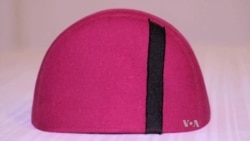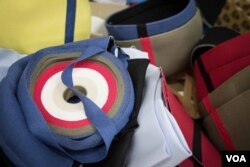The tarboosh, or fez, once a common sight in Middle Eastern countries, may be set for a 21st-century revival.
Having quit the lucrative world of finance, entrepreneur Elias El Haddad is pressing ahead with his forward-looking take on a hat that once adorned sultans and farmers alike.
The result, hats named Boshies, may upset traditionalists, coming as they do in a variety of colors, a new shape, and a stripe instead of the famous tassel that usually sits atop the tarboosh.
But in looking to solve what he dubbed “the tarboosh problem,” El Haddad said he was aiming higher than selling a few hats and causing a brief stir.
Lebanon-born, El Haddad spent his 20s in Europe, studying in Lyon before a career in the banking sector took him to Paris, London and Geneva, among other places. The experience showed El Haddad that he definitely did not want to work in banking.
Another path
But as one door closed, another opened.
El Haddad noticed there were no Middle Eastern clothing retailers offering affordable, fresh expressions of his native culture on European high streets.
So, having quit his job and returned to Beirut, a city he saw “transformed” by new, entrepreneurial talent, he set his sights on filling that gap.
All he needed was an iconic item of clothing that was ready for reinvention.
“People have this big complex with the tarboosh," he said. "They’re not proud of it, they’re ashamed of it, and it’s falling into oblivion.”
Strong words, but the hat’s decline is clear. The presence of the tarboosh in Lebanon has been largely reduced to its presence in tourist shops, a tale replicated across much of the Middle East.
El-Haddad, 34, dug into the tarboosh's past with the zeal of a historian. What he found expressed much about the shifting currents of the Arab world.
The origins of the tarboosh are disputed, but it is thought to have had an early presence in Turkey and the Balkans.
Sultan's decree
The hat came to prominence in the Middle East in the early 19th century when Sultan Mahmud II, Turkish sultan of the Ottoman Empire, demanded that his civil servants wear the hat instead of turbans.
It was a move seen as part of wider modernizing, Western-leaning measures taken by the sultan.
“Fashion filters down in a hierarchical order,” said anthropologist and tarboosh expert Maha Kayal. The leaders of the empire “became an example, a role model for the officials and the people highly placed in Ottoman countries, who began following the fashion.”
And so the presence of the tarboosh spread, and it came to represent different things in different countries across the Middle East and beyond.
In Lebanon, Kayal said, far from being pro-European, it became a symbol of defiance against the French mandate, which began in 1923 and lasted more than 20 years.
Within a few decades, however, the hat had begun its decline.
It is this sense of decline that El Haddad told VOA he wanted to reverse with his Boshies. In doing so, he said, he hopes to help a new generation of Middle East residents recognize the achievements of their ancestors.
“I wanted to bring my small contribution to the revival of our culture, and reconnect the youth with its past glory,” he said. “Now is the time for my generation to wake up and say we can be universally known for our culture, for things like our food, our music, our art.”
Marketed to women, too
Not that he is entirely misty-eyed about the history of the tarboosh.
El Haddad is consciously marketing his new design to women as well as men, in a refutation of the patriarchy he sees embodied within the tarboosh tradition.
He is also keen to keep production ethical. The hats are made at the Institut de Reeducation Audio-Phonetique, where hearing-impaired Lebanese are given the chance for employment.
Having been launched just this year, Boshies can be found in only a few shops so far, but El Haddad is on the hunt for investors and thinking big. He is already lining up new products to launch, and a custom hat was worn last month by pop star Mika.
And in Decale, a design shop in Beirut’s upper-market Achrafieh district, browsing customer Randa Tabbah was impressed.
“When I first saw it I was reminded of the tarboosh. Then it was clear it was one, but revisited,” said Tabbah, herself a designer. “I found it a brilliant idea, and I think it’s going to be successful.”









